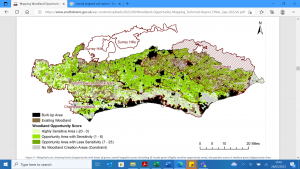Our guest blogger for this week is Sarah Brotherton from Wild Bourne, the newest working group within the Eastbourne Eco Action Network:
One of the ways in which we can tackle the climate crisis is through tree planting. However, this may not be as simple as it seems, it is certainly not a quick solution, and it is definitely not a substitute for reducing CO2 and other greenhouse gas emissions.
Why are trees and woodlands so important in tackling the climate crisis? Because they store carbon within their structures, or biomass as it is technically referred to. However, it is worth pointing out that equal or even greater amounts of carbon are stored in woodland soils, so it is not just the tree it is what is below the tree that is also important. while woodland soils store substantial amounts of carbon, many grassland soils, particularly those of wet grasslands, and other wetland habitats store vastly more carbon than woodland soils1. Which is good to know, because although Eastbourne does not have a lot of tree cover, especially as woodland, it has large areas of wet grassland in the form of grazing marsh in the Eastbourne Park and Eastbourne levels areas.
East Sussex is one of the most wooded counties in England, with 17% woodland cover compared to the national average of 12.5%. But if you live in Eastbourne, that might seem a stretch to imagine given that Eastbourne and much of the surrounding landscape are not very wooded. That is because the bulk of woodland in the county is within the High Weald, north of Horam, which is in fact the most woodland landscape in the whole of England.
So, does this mean lots of tree planting should be happening in and around Eastbourne? Well, this is actually quite a complex question. Eastbourne has a completely different underlying geology to the High Weald, which has led to a different historical land use, and that in turn has led to the development of very different, but no less important habitats, which is why the landscape around Eastbourne and the Downs at this Eastern end are characteristically different from the low and high Weald of Sussex. Take the chalk grassland on Eastbourne’s doorstep on the Downs. This is an internationally rare habitat, with 80% of the original extent of chalk grassland lost since WWII. Much of the loss in the last 80 years has been to arable conversion on the dip slopes and spreading secondary woodland on the scarp slopes. Secondary woodland is tree and shrub cover that has naturally regenerated because of extensification – the opposite of agricultural intensification – the land is no longer actively managed.
The South Downs National Park Authority in conjunction with Sussex Nature Partnership have produced an ArcGIS map which helps to sense check potential sites across both East and West Sussex, and the full extent of the South Downs National Park for woodland creation. This map draws on national and local data and is the best woodland opportunity mapping tool we have because it has been developed specifically to be used locally. It removes areas not suitable for woodland creation that are often other important habitats, it then weighs both positive and negative factors of the remaining areas across the counties to give one of three scores depending on how sensitive (suitable) the area is for tree planting. The one down side to this excellent tool is that is cannot be used to ascertain suitability for urban tree planting, as urban areas are screened out.

Image source: Mapping Woodland Opportunity in Sussex and the South Downs National Park Technical report, 2022
The map can be found by clicking on the link below. There is a storymap element which explains how the maps work, but if you scroll to the bottom there is an interactive map, which is zoomable:
Sussex and South Downs Woodland Opportunity Mapping (arcgis.com)
This mapping work suggests there is not a great deal of opportunity for woodland creation around Eastbourne. But that is OK, because Eastbourne has other naturally occurring habitats that are just as important if not more important in the fight against climate change. And anyway, the rest of Sussex, and in particular the High Weald AONB holds a place for us with its woodland cover, the same way that the Downs holds chalk grassland for the rest of Sussex. It is a reminder that looking after and restoring all habitats for biodiversity and for us is important, including for future generations, regardless of where those habitats are found.
1 R Gregg, J. L. Elias, I Alonso, I.E. Crosher and P Muto and M.D. Morecroft (2021) Carbon storage and sequestration by habitat: a review of the evidence (second edition) Natural England Research Report NERR094. Natural England, York
